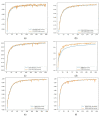Hybrid Deep Learning Approach for Stress Detection Using Decomposed EEG Signals
- PMID: 37296788
- PMCID: PMC10252840
- DOI: 10.3390/diagnostics13111936
Hybrid Deep Learning Approach for Stress Detection Using Decomposed EEG Signals
Abstract
Stress has an impact, not only on a person's physical health, but also on the ability to perform at the workplace in daily life. The well-established relation between psychological stress and its pathogeneses highlights the need for detecting psychological stress early, in order to prevent disease advancement and to save human lives. Electroencephalography (EEG) signal recording tools are widely used to collect these psychological signals/brain rhythms in the form of electric waves. The aim of the current research was to apply automatic feature extraction to decomposed multichannel EEG recordings, in order to efficiently detect psychological stress. The traditional deep learning techniques, namely the convolution neural network (CNN), long short-term memory (LSTM), bidirectional long short-term memory (BiLSTM), gated recurrent unit (GRU) and recurrent neural network (RNN) models, have been frequently used for stress detection. A hybrid combination of these techniques may provide improved performance, and can handle long-term dependencies in non-linear brain signals. Therefore, this study proposed an integration of deep learning models, called DWT-based CNN, BiLSTM, and two layers of a GRU network, to extract features and classify stress levels. Discrete wavelet transform (DWT) analysis was used to remove the non-linearity and non-stationarity from multi-channel (14 channel) EEG recordings, and to decompose them into different frequency bands. The decomposed signals were utilized for automatic feature extraction using the CNN, and the stress levels were classified using BiLSTM and two layers of GRU. This study compared five combinations of the CNN, LSTM, BiLSTM, GRU and RNN models with the proposed model. The proposed hybrid model performed better in classification accuracy compared to the other models. Therefore, hybrid combinations are appropriate for the clinical intervention and prevention of mental and physical problems.
Keywords: BiLSTM; CNN; DWT; EEG; GRU; LSTM.
Conflict of interest statement
The authors declare no conflict of interest.
Figures











Similar articles
-
Epileptic seizure detection in EEG signals using deep learning: LSTM and bidirectional LSTM.Comput Methods Biomech Biomed Engin. 2025 Apr 21:1-24. doi: 10.1080/10255842.2025.2490136. Online ahead of print. Comput Methods Biomech Biomed Engin. 2025. PMID: 40255197
-
An emotion recognition method based on EWT-3D-CNN-BiLSTM-GRU-AT model.Comput Biol Med. 2024 Feb;169:107954. doi: 10.1016/j.compbiomed.2024.107954. Epub 2024 Jan 1. Comput Biol Med. 2024. PMID: 38183705
-
An Effective Hybrid Deep Learning Model for Single-Channel EEG-Based Subject-Independent Drowsiness Recognition.Brain Topogr. 2024 Jan;37(1):1-18. doi: 10.1007/s10548-023-01016-0. Epub 2023 Nov 23. Brain Topogr. 2024. PMID: 37995000
-
A Review of Methods for Sleep Arousal Detection Using Polysomnographic Signals.Brain Sci. 2021 Sep 26;11(10):1274. doi: 10.3390/brainsci11101274. Brain Sci. 2021. PMID: 34679339 Free PMC article. Review.
-
A Review on Mental Stress Assessment Methods Using EEG Signals.Sensors (Basel). 2021 Jul 26;21(15):5043. doi: 10.3390/s21155043. Sensors (Basel). 2021. PMID: 34372280 Free PMC article. Review.
Cited by
-
The Effect of Stress on a Personal Identification System Based on Electroencephalographic Signals.Sensors (Basel). 2024 Jun 27;24(13):4167. doi: 10.3390/s24134167. Sensors (Basel). 2024. PMID: 39000946 Free PMC article.
-
A Hybrid Wavelet-Based Deep Learning Model for Accurate Prediction of Daily Surface PM2.5 Concentrations in Guangzhou City.Toxics. 2025 Mar 28;13(4):254. doi: 10.3390/toxics13040254. Toxics. 2025. PMID: 40278570 Free PMC article.
-
Novel accurate classification system developed using order transition pattern feature engineering technique with physiological signals.Sci Rep. 2025 May 1;15(1):15278. doi: 10.1038/s41598-025-00071-w. Sci Rep. 2025. PMID: 40312463 Free PMC article.
-
A Novel Optimized Hybrid Deep Learning Framework for Mental Stress Detection Using Electroencephalography.Brain Sci. 2025 Aug 4;15(8):835. doi: 10.3390/brainsci15080835. Brain Sci. 2025. PMID: 40867167 Free PMC article.
References
-
- Sharma R., Chopra K. EEG signal analysis and detection of stress using classification techniques. J. Inf. Optim. Sci. 2020;41:229–238. doi: 10.1080/02522667.2020.1714187. - DOI
-
- Singh S.K., Singh S.S., Singh V.L. Predicting adoption of next generation digital technology utilizing the adoption-diffusion model fit: The case of mobile payments interface in an emerging economy. Access J. 2023;4:130–148. doi: 10.46656/access.2023.4.1(10). - DOI
-
- Cheema A., Singh M. Psychological stress detection using phonocardiography signal: An empirical mode decomposition approach. Biomed. Signal Process. Control. 2019;49:493–505. doi: 10.1016/j.bspc.2018.12.028. - DOI
LinkOut - more resources
Full Text Sources

